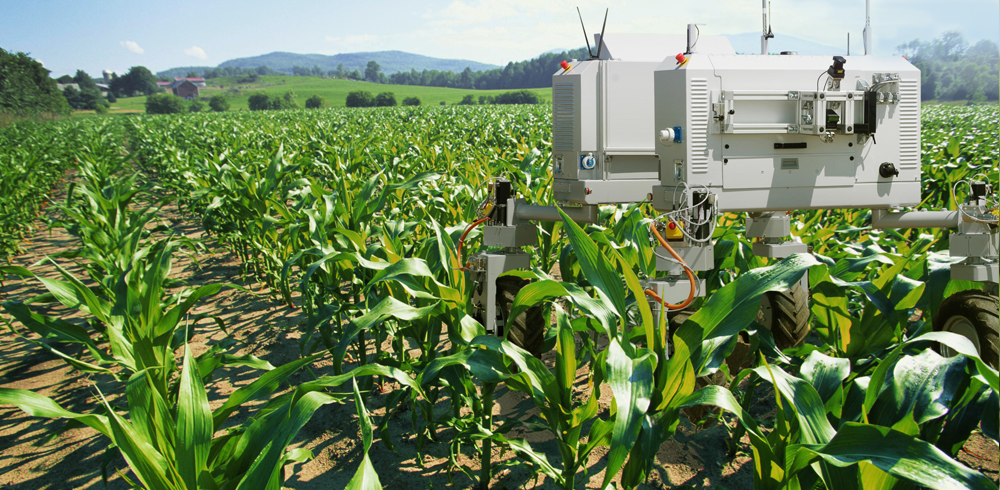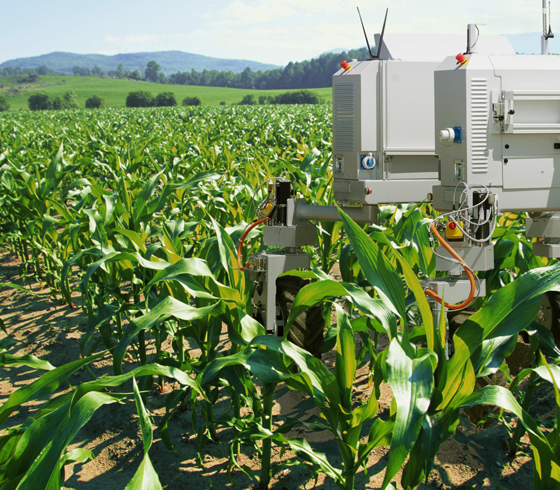

News
AI-powered robots answer US farmers’ call amid diminishing labor force
Facing a diminishing workforce, some farmers in the United States are looking to artificial intelligence as a means to adapt to the changing labor landscape. In Florida, for example, Gary Wishnatzki of Wish Farms is rolling out AI-powered robots that are capable of picking his crops.
Wish Farms in FL made a name for itself as a producer of premium strawberries and blueberries. Strawberries are a particularly demanding crop; since every three days, the plant will give off new ripe fruit. If these fruits are not harvested according to their cycle, the strawberry plant dies.
According to Wishnatzki, his farms need around 600 workers to harvest his 600 acres of crops every two or three days. Thus, during season, workers are faced with very few rest days. In a statement to CBS News, Wishnatzki noted that his farms’ labor force, a significant number of whom is from Mexico, has been facing challenges over the past 15 years.
“We’ve seen a shrinking labor force and an aging labor force. People just aren’t showing up anymore to do this work. I started to look at what was really causing it. It was more of a demographic issue than a political issue or anything else. As the Mexican economy continues to improve as more fruit is being grown in Mexico, people aren’t going to be coming anymore,” Wishnatzki said.
In order to address his farm’s shortage of workers, Wishnatzki looked to automation through AI-powered robots. He co-founded Harvest CROO Robotics, a company aimed at developing a machine that can pick crops using robots and artificial intelligence. A few years later, Harvest CROO has created an AI-powered robot that uses imaging technology to determine which berries are ripe enough to pick. The technology behind the AI-powered robot was described to CBS News by Paul Bisset, Harvest CROO’s CEO.
“We’re collecting 50 to 100 images a plant, and all of those images are fed into our AI system in order to tell us, OK, this is a good berry, this is one we want to go after,” Bisset said.
Even farming giants are turning to Silicon Valley to advance their operations. Farming equipment producer John Deere, for one, has opened an office in San Francisco aimed at developing smart solutions that can be used for the agricultural sector. Alex Purdy, the head of John Deere Labs, stated that the future of farming lies in advanced tech.
“We know that we absolutely need to go and seek out capabilities in machine learning, in deep learning, in robotics and advanced analytics. And Silicon Valley has been receptive,” he said.
As we noted in a previous report, using technology in agriculture has been the focus of Kimbal Musk through his company, Square Roots. Square Roots converts old shipping containers into advanced vertical farms, which would enable even the most populated cities to have access to fresh, organic food. So far, Kimbal’s initiative continues to gain ground, just as his nonprofit, Big Green, continues to expand its reach into schools across America.

News
Tesla FSD fleet is nearing 7 billion total miles, including 2.5 billion city miles
As can be seen on Tesla’s official FSD webpage, vehicles equipped with the system have now navigated over 6.99 billion miles.

Tesla’s Full Self-Driving (Supervised) fleet is closing in on almost 7 billion total miles driven, as per data posted by the company on its official FSD webpage.
These figures hint at the massive scale of data fueling Tesla’s rapid FSD improvements, which have been quite notable as of late.
FSD mileage milestones
As can be seen on Tesla’s official FSD webpage, vehicles equipped with the system have now navigated over 6.99 billion miles. Tesla owner and avid FSD tester Whole Mars Catalog also shared a screenshot indicating that from the nearly 7 billion miles traveled by the FSD fleet, more than 2.5 billion miles were driven inside cities.
City miles are particularly valuable for complex urban scenarios like unprotected turns, pedestrian interactions, and traffic lights. This is also the difference-maker for FSD, as only complex solutions, such as Waymo’s self-driving taxis, operate similarly on inner-city streets. And even then, incidents such as the San Francisco blackouts have proven challenging for sensor-rich vehicles like Waymos.
Tesla’s data edge
Tesla has a number of advantages in the autonomous vehicle sector, one of which is the size of its fleet and the number of vehicles training FSD on real-world roads. Tesla’s nearly 7 billion FSD miles then allow the company to roll out updates that make its vehicles behave like they are being driven by experienced drivers, even if they are operating on their own.
So notable are Tesla’s improvements to FSD that NVIDIA Director of Robotics Jim Fan, after experiencing FSD v14, noted that the system is the first AI that passes what he described as a “Physical Turing Test.”
“Despite knowing exactly how robot learning works, I still find it magical watching the steering wheel turn by itself. First it feels surreal, next it becomes routine. Then, like the smartphone, taking it away actively hurts. This is how humanity gets rewired and glued to god-like technologies,” Fan wrote in a post on X.
News
Tesla starts showing how FSD will change lives in Europe
Local officials tested the system on narrow country roads and were impressed by FSD’s smooth, human-like driving, with some calling the service a game-changer for everyday life in areas that are far from urban centers.

Tesla has launched Europe’s first public shuttle service using Full Self-Driving (Supervised) in the rural Eifelkreis Bitburg-Prüm region of Germany, demonstrating how the technology can restore independence and mobility for people who struggle with limited transport options.
Local officials tested the system on narrow country roads and were impressed by FSD’s smooth, human-like driving, with some calling the service a game-changer for everyday life in areas that are far from urban centers.
Officials see real impact on rural residents
Arzfeld Mayor Johannes Kuhl and District Administrator Andreas Kruppert personally tested the Tesla shuttle service. This allowed them to see just how well FSD navigated winding lanes and rural roads confidently. Kruppert said, “Autonomous driving sounds like science fiction to many, but we simply see here that it works totally well in rural regions too.” Kuhl, for his part, also noted that FSD “feels like a very experienced driver.”
The pilot complements the area’s “Citizen Bus” program, which provides on-demand rides for elderly residents who can no longer drive themselves. Tesla Europe shared a video of a demonstration of the service, highlighting how FSD gives people their freedom back, even in places where public transport is not as prevalent.
What the Ministry for Economic Affairs and Transport says
Rhineland-Palatinate’s Minister Daniela Schmitt supported the project, praising the collaboration that made this “first of its kind in Europe” possible. As per the ministry, the rural rollout for the service shows FSD’s potential beyond major cities, and it delivers tangible benefits like grocery runs, doctor visits, and social connections for isolated residents.
“Reliable and flexible mobility is especially vital in rural areas. With the launch of a shuttle service using self-driving vehicles (FSD supervised) by Tesla in the Eifelkreis Bitburg-Prüm, an innovative pilot project is now getting underway that complements local community bus services. It is the first project of its kind in Europe.
“The result is a real gain for rural mobility: greater accessibility, more flexibility and tangible benefits for everyday life. A strong signal for innovation, cooperation and future-oriented mobility beyond urban centers,” the ministry wrote in a LinkedIn post.
News
Tesla China quietly posts Robotaxi-related job listing
Tesla China is currently seeking a Low Voltage Electrical Engineer to work on circuit board design for the company’s autonomous vehicles.

Tesla has posted a new job listing in Shanghai explicitly tied to its Robotaxi program, fueling speculation that the company is preparing to launch its dedicated autonomous ride-hailing service in China.
As noted in the listing, Tesla China is currently seeking a Low Voltage Electrical Engineer to work on circuit board design for the company’s autonomous vehicles.
Robotaxi-specific role
The listing, which was shared on social media platform X by industry watcher @tslaming, suggested that Tesla China is looking to fill the role urgently. The job listing itself specifically mentions that the person hired for the role will be working on the Low Voltage Hardware team, which would design the circuit boards that would serve as the nervous system of the Robotaxi.
Key tasks for the role, as indicated in the job listing, include collaboration with PCB layout, firmware, mechanical, program management, and validation teams, among other responsibilities. The role is based in Shanghai.
China Robotaxi launch
China represents a massive potential market for robotaxis, with its dense urban centers and supportive policies in select cities. Tesla has limited permission to roll out FSD in the country, though despite this, its vehicles have been hailed as among the best in the market when it comes to autonomous features. So far, at least, it appears that China supports Tesla’s FSD and Robotaxi rollout.
This was hinted at in November, when Tesla brought the Cybercab to the 8th China International Import Expo (CIIE) in Shanghai, marking the first time that the autonomous two-seater was brought to the Asia-Pacific region. The vehicle, despite not having a release date in China, received a significant amount of interest among the event’s attendees.








